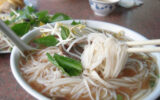South East Asia has a significant Chinese population scattered across several countries. Diverse and assimilated cultures mean that it is celebrated slightly differently in various countries. Here are 5 in South East Asia and their take on Chinese New Year.
ThailandChinese New Year celebrations in Thailand last for about three days. The eve of Chinese New Year is called ‘Wan Jai’ where the people will shop and prepare fresh foods and material for their gods and ancestors. The actual day itself is called ‘Wan Wai’ or the day of praying for prosperity for the whole year. ‘Wan Tiew’ on the following day is the day of relaxing where the Thais are not likely to work and refrain from saying bad words.
Chinese Population: 14%
Local Chinatown: Yaowarat in Bangkok
Ang pow: Young non-married individuals will typically receive from the senior members of the family. Giving and receiving 500 – 1000 Baht is common but the amount really differs based on people.
Phrases: “Xin Jia Yu Yi Xin Ni Hua Xai” which translates to wishing you happy and prosperous new year in the Teochew dialect.
Taboo: The Thais avoid eating porridge during this season because the dish is cooked with a small amount of rice and a lot of water which could signify living in hardship with not enough food for the year.
Vietnam
The Chinese people have deep roots in Vietnam and their celebration is no less spectacular than any other country. Tết is celebrated not only by the Chinese-Vietnamese but by the whole population of Vietnam to ring in the Lunar New Year. They do have distinctive customs like the presence of two foods that must be displayed typically in the living room, the rice cake “Bánh Chưng” and watermelon or “Dưa Hấu”. These two foods signify the welcoming of guests.
Chinese Population: > 1%
Also Known As: Tết
Local Chinatown: District 5 or Cholon in Ho Chi Minh City
Ang pow: In Vietnam, ang pow is known as “Lì Xì” where brand new money notes are given. How much is given depends on your financial status, but the wishing of luck towards the person you are giving it to is more important than the amount. 50,000 VND is a quite a common figure to give.
Taboo: Vietnamese do not sweep the house during the first 3 days of Chinese New Year so they would not sweep away their wealth and luck.
Indonesia
After interviewing a local Chinese Indonesian, I noticed that their celebration of Chinese New Year is pretty similar to that of Malaysia Chinese. Locals celebrate up to 5 days where the first few are for visiting relatives while the latter is when the celebration continues with friends and neighbours. Similar to Malaysians, they pray for their ancestors during the eve of Imlek and often visit the many Chinese temples during the first day to pay respects.
Chinese Population: 3%
Also Known As: Imlek
Local Chinatown: Glodok
in Jakarta or Solo and Semarang in Central Java
Phrases used:
Tang Tang Ju Ni – Expressed to the older generation to wish them a healthy and happy life.
Tang Tang Tua Thang – Uttered to the working group to wish them fortune and wealth
Ang pow: Those who start working usually start giving ang pows while parents and in-laws are commonly given to in the family. Uniquely, the ang pow amount is usually given in even numbers like IDR60,000.
Cambodia
Chinese in Cambodia are a hard-working people but they do take time off to celebrate the Lunar New Year which usually lasts 1 week. Preparations happen weeks before in the capital of Phnom Penh where customers crowd the shops to purchase materials for decorations and prayers. The decorations range from lanterns to candles and the popular plum blossom saplings that are widely known as a symbol of fortune.
Chinese Population: 1%
Also Known As: The Spring Festival
Ang pow: The ang pow is given to the older generation as well as the young ones. Plus, in the working work, many companies give one-month bonuses to their employees during the month of the Chinese New Year.
Taboos: During this season, they advocate to speak kindly to others and avoid harsh words.
Malaysia
The celebration of Chinese New Year in Malaysia is known to be one of the biggest in South East Asia. Shopping malls and the streets are decorated with lights and symbols representing all things auspicious and lucky. Malaysia’s love of food also spills onto this favourite holiday with the tossing of the ‘Yee Sang’ or ‘Yu Sheng’ (raw fish salad) that take place at family houses and fancy hotels among colleagues. The Yee Sang usually comprises of seven symbolic ingredients which are “tossed” using chopsticks, aiming high for higher fortunes while wishing common lucky phrases like ‘Xin Nian Kuai Le’.
Chinese Population: 23%
Local Chinatown: Petaling Street in Kuala Lumpur
Ang pow: Only people who have entered matrimony give ang pow and those who are not married, will still be eligible to receive despite your age. Some Chinese even give their parents ang pow as a token of appreciation.
Phrases used:
Xin Nian Kuai Le – Happy new year
Yi Lu Shun Feng – Safe journey ahead
Yi Nian Zhi Ji Zai Yi Chun – To achieve a good year ahead, best to start plan during Springtime
Taboo: Chinese in Malaysia do not sweep the floor during the first day Chinese New Year celebration as to not sweep away luck and fortune. Black and White clothing and decorations are to be avoided as well as they are not auspicious colours.
CNY FUN FACTS
- Japan’s Chinese New Year is largely celebrated in Yokohama Chinatown, Kanagawa Prefecture, home to the largest Chinese population in the country. Held on 15 Feb – 2 March 2018.
- Korea’s Lunar New Year is known as Seollal, an important tradition of the nation where most locals will be dressed in hanboks. Tteokguk is a typical Seollal soup dish with rounded coin-shaped rice cakes that symbolises prosperity to the eater.
- A cultural destination for the annual Chinese New Year in the Philippines is in Binondo, the world’s oldest Chinatown. Chinoy folks will give tikoy – Philippines glutinous rice dessert – as New Year gifts.
Words by Aishah Azali


